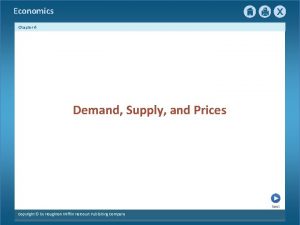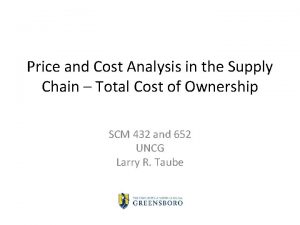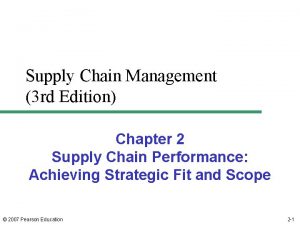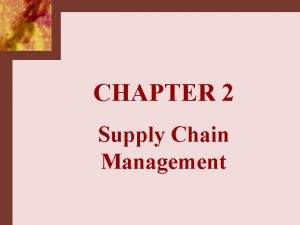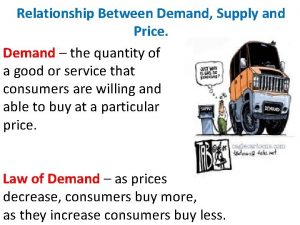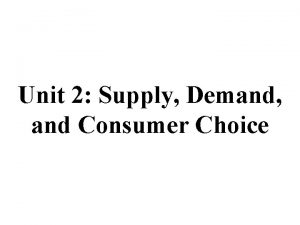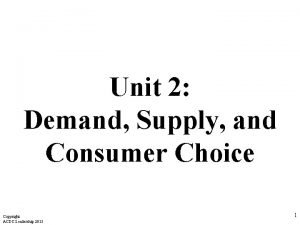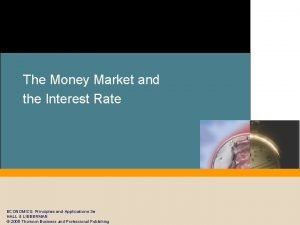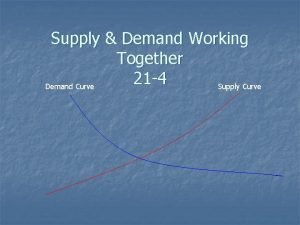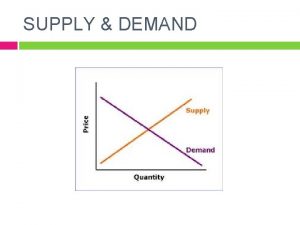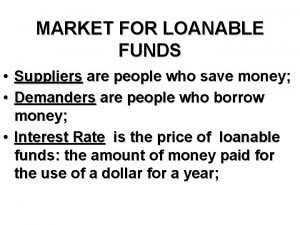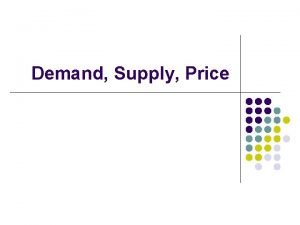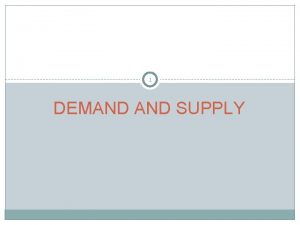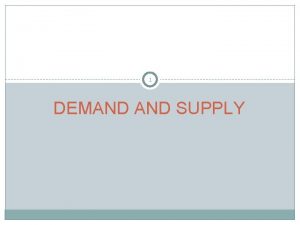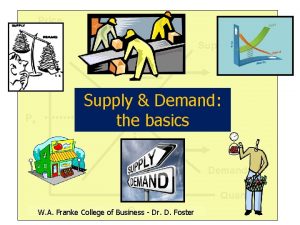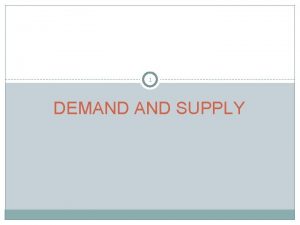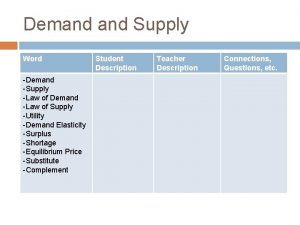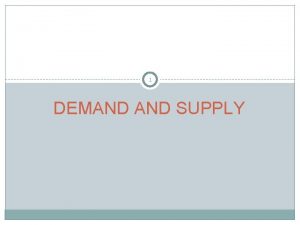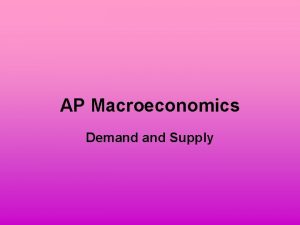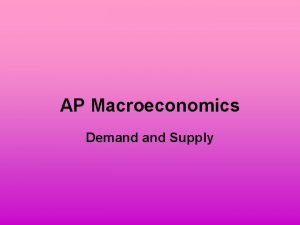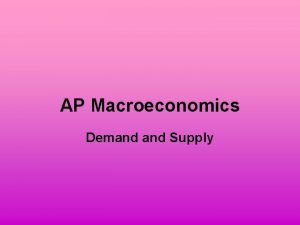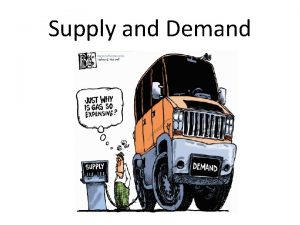COST DEMAND SUPPLY AND PRICE MANAGEMENT IN THE























- Slides: 23

COST, DEMAND SUPPLY AND PRICE MANAGEMENT IN THE POWER MARKET BY PROF. J. O. ALIMBA Being a Presentation at the Workshop on Electricity Economics to PHCN Staff at Abuja 26 – 28 March, 2010

Introduction: l l The main objective of this paper is to analyze the power market with respect to cost, supply and demand price management with reference to the Nigerian power sector. If developing countries have learned anything from the previous ‘failed’ attempts at power system planning, it is that the power market can only be fully appreciated in the broader context of the underlying drivers of cost, demand supply and price management. What this might mean in building new power stations and privatization of the power sector is equally very important. This paper will attempt to look at – – – (i) the power market and its features, (ii) cost, demand supply are defined analyzed in relation to the power market, (iii) pricing and price management in the power market. The power market for the purpose of this paper will refer to electricity market.

The Electricity Power Market and Its Features: l l To an economist a market in technical usage is concerned with the entire web of interrelationship between, the buyers and the sellers of a particular product, involved in exchange and distribution of wealth and income. The electricity power market is any arrangement that brings the generated power of a firm or firms to the consumer at an agreed price. Electricity Market is based on either a pooled framework or bilateral contracts. Recent efforts made in many countries of the world to restructure electricity markets have renewed interest in electricity supply demand pricing.

Features of Un-reformed Power Market: The features of this market can be assessed by: l The market structure it is operating – usually a monopoly market structure controlled by a state-owned monolith (e. g. the former Nigeria Electric Power Authority, NEPA). l The monolith is incharge of generation, transmission and distribution. l As a monopolist, it is supposed to be making above normal profit. l It has a burden of subsidies, low service quality, poor collection of tariff, high network losses, and poor service coverage. l On welfare implications, the charge (tariff) of the monopolist could lead to Pareto sub-optimal conditions (inefficiency)

Features of Reformed (Competitive) Power Market: l l l Usually of oligopolistic market structure, of few firms (e. g. the PHCN unbundled into 6 generation, 1 transmission and 11 distribution companies. Aims to create viable commercial entities that would lend themselves to efficiency improvements. Competition in generation and supply is ensured and efficiency may lead to tariff reduction. Oligopolistic interdependence ensures checks and balances in price and non-price manipulations. Pursues efficiency in resource use and full cost recovery. If fully operated as a reformed market, the Nigerian power market will have a chain of Oligopolistic power generating firms; a monopolistic power transmitting firm, and a chain of oligopolistic power distribution firms. Prices may be determined on a cost-plus basis either by negotiations or by the regulator (NERC) and this may constitute a perfect recipe for delivering high cost power to the consumers (if there is no forms of subsidy).

Features of Oligopoly Market Structure l l Oligopoly is a market situation in which the number of sellers dealing in a homogeneous or differentiated product is small. It is known as competition among the few. Some features of this market are: – – – Few sellers Interdependence Advertisement: Competition: Lack of Uniformity:

Concept of Cost in the Power Market: l l The firm’s costs determine its supply. Supply along with demand determine price. To understand the process of price determination and the forces behind supply, we must understand the nature of costs. The nature of costs refers to the cost – output relation during the short and long periods. This is also known as cost functions. Money cost are the total money expenses incurred by a firm in producing a commodity or service, such as cost of machines, energy salaries and wages, interest on capital etc. Total cost of power production can be explicit or implicit. Explicit costs are those incurred by the power production firm in buying goods and services directly (e. g. machinery, energy, salaries and wages) etc used in production. Implicit costs are imputed value of entrepreneur’s own resources and services (e. g. rent of building and expertise) belonging to the entrepreneur. Total cost of production can further be divided into Total Variable Costs (TVC) which are expenses of production, which change with change in firm’s output. Total Fixed Cost (TFC) are those expenses on production which do not change with the change in output. They are sometimes described as overheads in business parlance.

Opportunity Cost l l is the measure of real cost in modern economics. It is also called alternative cost. In this context, the opportunity cost to a power firm is the revenue forgone by not using those resources invested in power production in their next best alternative use. In estimating opportunity costs, economists take a wider view of costs than accountants. Currently in Nigeria, much of the investment costs in the power market is by government. Such investment costs include money costs and opportunity costs. The state still incurs over 95% cost of generation, transmission and distribution. The country is still at the transitory stage of privatization. Therefore the cost of production of a unit of power will include Total Cost (TC) (which includes TVC and TFC) of generation, transmission and distribution to end-users.

Demand Supply in the Power Market: l l l An individuals demand for power is the quantity of electric power that the individual (firm) is willing and able to buy during a time period. This may usually be influenced by these classical factors or determinants. The price of a unit of power x (Px) The prices of other alternative power sources such as solar power, generator power etc (Pr) The power consumer’s income (y) The consumers expectations about future prices of power (E) Level of advertising (awareness creation) (A) Other relevant factors (Z) This can be put in a simple implicit functional form, called the power demand function; dx = f(Px, Pr, y E, A, Z) Although all the factors or determinants are important, the price of unit of power is the most important determinant of demand. If we assume all other determinants constant, we just can write; dx = f(Px), ceteris paribus. Put simply, the individual’s demand for (X) units of electricity is determined by the price, assuming that other influencing factors are held constant.

The Market Demand l l The market demand for power is the sum of all the individual demands in the economy. This again is influenced by price; and the prices of other related sources of power. A simple law of demand states that a rise in the price of a commodity (electric power) leads to a fall in the total quantity demanded, while a fall in prices leads to rise in quantity demanded.

Market Supply for Power l l l The market supply of a good (electric power) is the sum of the quantities of a good that individual firms are willing and able to offer for sale over a given time period. The main determinants of market supply of power will include: The objective of the firms in the industry (O) The price of a unit of electricity (Px) The price of other related power sources (Py) The price of factors of production (Pf) The state of technology (T) Expectations (E) An implicit functional form of this can be written as: Sx = f(O, Px, Py, Pg, Pf, T, E, Z), where Z, is all other relevant factors. In a competitive market (for every reformed power market), where profit motive is a major objective of firms, the relationship between supply and price is likely to be positive, hence we assume, Sx = f(Px), ceteris paribus.

Equilibrium in Power Market and Gaps: l Since price is the main driver of demand supply in the power market, it is important for firms in the market to strive to have appropriate demand supply price. This may be in form of equilibrium market price, which is the price at which the quantity demanded of a commodity (electricity) is equal to the quantity supplied. This is also known as the market-clearing price. l An illustration: we may take a simple demand supply curves to illustrate this Price of a unit of electricity S D pe e D qe Quantity of electricity/Time period

l l l In the figure above, the point at which the demand supply curves intersect determines the equilibrium price, Ope, and quantity, Oqe. Comparing one equilibrium state with another at a moment in time (often called comparative static equilibrium analysis) is very important when attempting to understand the concept of equilibrium. In the market for power, such a state of rest can be said to exist when there is neither any excess demand for nor supply of power. In other words, the general rule for equilibrium to exist in a market is that demand should be equal to supply. Any distortion to this rule leads to demand - supply gap in the market for power; and disequilibria in prices. Estimating the level of demand supply in the power market and hence equilibrium and level of dis-equilibrium (gap) at any point in time is not easy especially in developing countries.

Gap in Demand Supply of Power l l l A gap in electricity demand/supply reflects the deference between a forecast peak demand the effective capacity expected to be available to supply that peak demand. This type of demand/supply gap should be the basis of electric power planning in any reforming country. The demand – supply gap provides a simple and compelling framework for thinking about the future, but ‘gapology’ has not been effectively used as the basis for investment planning in most development countries power system. Under-estimation or overestimation will undermine investment in the power market, and attempt at ‘balancing of power’ in any country. It will also affect costing of investment and therefore in appropriate pricing of power, and price management. Any agency charged with providing advice on demand-supply gap of electricity must have a calm planning environment and given enough time. One of the first priorities of such agency would be to assemble the necessary databases and analytical tools needed for detailed scenario analysis of the system. This means databases that identify how electricity is used by sectors, and by end users. Also tools that allow the exploration of how the level and pattern of electricity use would vary, given different assumptions about future population, housing preferences, industrial structure, technological efficiency etc. It is not well known the capacity of developing countries (such as Nigeria) to analyze the demand for electricity and to construct useful and insightful scenarios, and databases of end-use patterns, technology saturation rates and market shares needed to support such analyses.

Electricity Generation and Consumption in Nigeria l l If we take total electricity generation (TG) and total consumption (TC) (Table 1) of Nigeria as proxies for total supply and total demand (for years 1995 to 2005), it is clearly seen that: Table 1: Electricity Generation and Consumption in Nigeria Year Installed capacity MW Total Generation MW/Hr Capacity Utilized % Total Consumption Mw/hr Proportion of Total Generation Consumed MW/Hr 1995 4548. 6 1810. 1 39. 0 1050. 9 59. 5 1996 4548. 6 1854. 2 39. 8 1033. 3 55. 7 1997 4548. 6 1839. 8 40. 8 1009. 6 54. 9 1998 4548. 6 1724. 9 37. 9 972. 8 56. 4 1999 5580. 0 1859. 8 33. 3 883. 7 47. 5 2000 5580. 0 1738. 3 31. 2 1017. 3 58. 5 2001 6180. 0 1689. 9 27. 5 1104. 7 65. 4 2002 1680. 0 2287. 3 36. 2 1271. 6 66. 8 2003 6130. 0 2680. 0 38. 8 1519. 5 63. 4 2004 6130. 0 2763. 6 45. 1 1825. 8 66. 1 2005 6861. 6 2779. 3 43. 5 1873. 1 67. 4

l l Power generation has not increased as increase in installed capacity in the 10 years being considered. The best being percentage capacity utilization of 45. 1 in 2004. Therefore, the highest percentage of installed capacity supplied was 45. 1% l Out of the quantity generated, the highest percentage consumption (demand) was 67. 4% in 2005. l The presentation in table 1 is very deceptive because it paints a picture that all that was generated was not consumed (i. e. supply is greater than demand) l But we know that ineffective transmission and distribution may have hindered consumption. l Also, only about 40% of Nigerian population has access to electricity

Closing the Gap in Power Market in Nigeria: Some attempts have been made to project power demand supply of Nigeria for 30 years as a way of attempting to close the gap in the market in the near future. l The project used IAEA Energy modeling tools of: l Model for the Analysis of Energy Demand (MAED) l Model for the Energy Supply strategy Alternatives and their General Environment Impact. (MESSAGE) Demand: l The energy (electricity) demand projections were computed using MAED, with key drivers of energy demand, namely demography socio-economic and technology. They used four economic scenarios based GDP growth. The result is shown in Table 2.

Table 2: Electricity Demand Projections Per Scenario (MW) Scenario 2005 2010 2015 2020 2025 2030 Reference (7% GDP) 5, 746 15730 28, 360 50, 820 77, 540 119, 200 High Growth (10%) 5, 746 15, 920 30, 210 58, 180 107, 220 119, 200 Optimistic 1(11. 5%) 5, 746 16, 000 31, 240 70, 760 137, 370 250, 000 Optimistic II (13%) 5, 746 33250 64, 200 107, 60 0 172, 900 297, 900 Source: Sambo A. S. 2008 Projected electricity demand has been translated into demand for grid electricity, peak demand, auxiliary consumption, load factor and declining non-grid generation.

Supply: Electricity Supply outlooks were computed using MESSAGE model, which utilized the projected energy demand as an input to produce supply strategy. MESSAGE takes into account demand variations of various final energy forms during the day, week and year, as well as different technological and political constraints to energy supply. The same scenarios used in demand were used in supply computations and projections. Table 3 Electricity Supply Projections Scenario 2005 2010 2015 2020 2025 2030 Reference (7% GDP) 6440 15668 28356 50817 77450 136879 High Growth (10%) 6440 15861 30531 54275 107217 192079 Optimistic 1(11. 5%) 6440 15998 31235 71964 177371 276229 Source: Sambo A. S. 2008 Based on the projections of demand supply in tables 2 and 3, could be seen that in year 2010, with 7% GDP growth, Nigeria should demand 15, 730 MW of electricity, and expect a supply of 15, 668 MW of electricity. This will tend to close the gap sufficiently enough between demand supply. Nigeria’s position, in terms of demand supply of electricity by this year 2010, remains guess.

Price Management in the Power Market: • Pricing and price management in the power market will depend on the market structure. The term market structure refers to a selected number of organizational characteristics of inter-relationships between buyers and sellers of a particular product. It has been identified that the market structure facing most reformed and reforming power market as in Nigeria is the Oligopoly market structure. The power market approximates pure oligopoly where a few sellers produce homogeneous product. But whether pure or differentiated oligopoly, pricing will come under three major heads: • Independent pricing Perfect collusion Price Leadership • •

Power Pricing Under Oligopoly Market: l l l The most likely pricing model of oligopoly firms in the power market is the fullcost pricing. Firms under oligopoly base their selling prices upon what is called ‘full-cost’ and including an allowance for profits, and not in terms of marginal cost and marginal revenue. Therefore, a price based on full average cost is the ‘right price’, which ‘ought to be charged’ based on the idea of ‘fairness to competition under oligopoly. Full cost is full average cost, which includes average variable (direct) cost (AVC) plus average fixed (overhead) costs AFC, plus a margin of profit. Oligopoly firms in the power market must insist on full recovery of costs, but the regulatory agency may participate in fixing their margins of profit. Nigeria for example has 3 phases of electricity deregulation as approved by the Federal Executive Council in 2001. They are: – – – The transition phase. The medium term (after unbundling and privatization). The long run competition structure.

MYTO l l l l The country is still grappling with the first two phases, even though the NERC has unveiled the Multi-Year- Tariff-Order (MYTO); designed for the period of July 1, 2008 – June 30, 2013. Although the new tariff rates implementation came into effect on July 1, 2008, electricity consumers would not pay the new reviewed rates – the Federal Government pays the difference between the new and old rates under a special subsidy arrangement named “Power Consumer Assistance Fund; managed by NERC. Whether electricity price (tariff) of MYTO was determined through full-cost method or any other method is not yet known. However, when the phase of long run competition structure takes effect, it is envisaged that competing firms may adopt the full-cost method of pricing. According to this phase, it is envisaged that the various power generation, transmission and distribution companies will be operating optimally. There would be economic pricing of electricity to cover the ‘full cost’ of supply, including expectations of a reasonable risk – adjusted rate of return on capital, opportunity for large industrial consumers to choose their suppliers, a well developed wholesale market with formal membership rules, procedures etc, and full retail sales competition. Power Market Prices can be most effectively managed through conscious attempt by firms and regulatory agency to maintain market-clearing prices. For Nigeria, in order to ensure adequate supply of electricity at minimum tariff under deregulation regime, it is necessary to pay attention to the development of transmission capacity. Regulatory policy may therefore be geared towards achieving this through rate of return regulation mechanism at both the transmission and distribution segments.

Conclusion: l The market structure facing most reformed power markets is the oligopoly market. This market structure determines the cost, demand supply conditions, and price management in the power market. Most reformed countries (especially developing ones) use a regulatory body to regulate the operations of firms in the power market. Overall there is need to carry out evidence-based studies such as demand supply situation in the power market, and even Willingness to Pay (WTP) for power before fixing price (tariff) for a unit of power.
 Module 5 supply and demand introduction and demand
Module 5 supply and demand introduction and demand Chapter 6 section 2 supply and demand in everyday life
Chapter 6 section 2 supply and demand in everyday life Matching supply and demand in supply chain
Matching supply and demand in supply chain Anong ibig sabihin ng price ceiling
Anong ibig sabihin ng price ceiling Supply chain management cost analysis
Supply chain management cost analysis Implied demand uncertainty in supply chain management
Implied demand uncertainty in supply chain management Cscmp meaning
Cscmp meaning Price discovery and price determination
Price discovery and price determination Deficient demand and excess demand
Deficient demand and excess demand Independent demand example
Independent demand example Demand schedule and demand curve tagalog
Demand schedule and demand curve tagalog Methods of demand estimation
Methods of demand estimation Distinguish between individual demand and market demand
Distinguish between individual demand and market demand Independent demand inventory
Independent demand inventory Demand management and capacity management
Demand management and capacity management What is the relationship between supply and price
What is the relationship between supply and price Unit 2 demand supply and consumer choice
Unit 2 demand supply and consumer choice Chapter 6 section 1 combining supply and demand answers
Chapter 6 section 1 combining supply and demand answers Unit 2 demand supply and consumer choice
Unit 2 demand supply and consumer choice Money market supply and demand
Money market supply and demand Combining supply and demand worksheet
Combining supply and demand worksheet Interaction of demand and supply
Interaction of demand and supply Who are the demanders of loanable funds
Who are the demanders of loanable funds Shifters of demand for loanable funds
Shifters of demand for loanable funds

